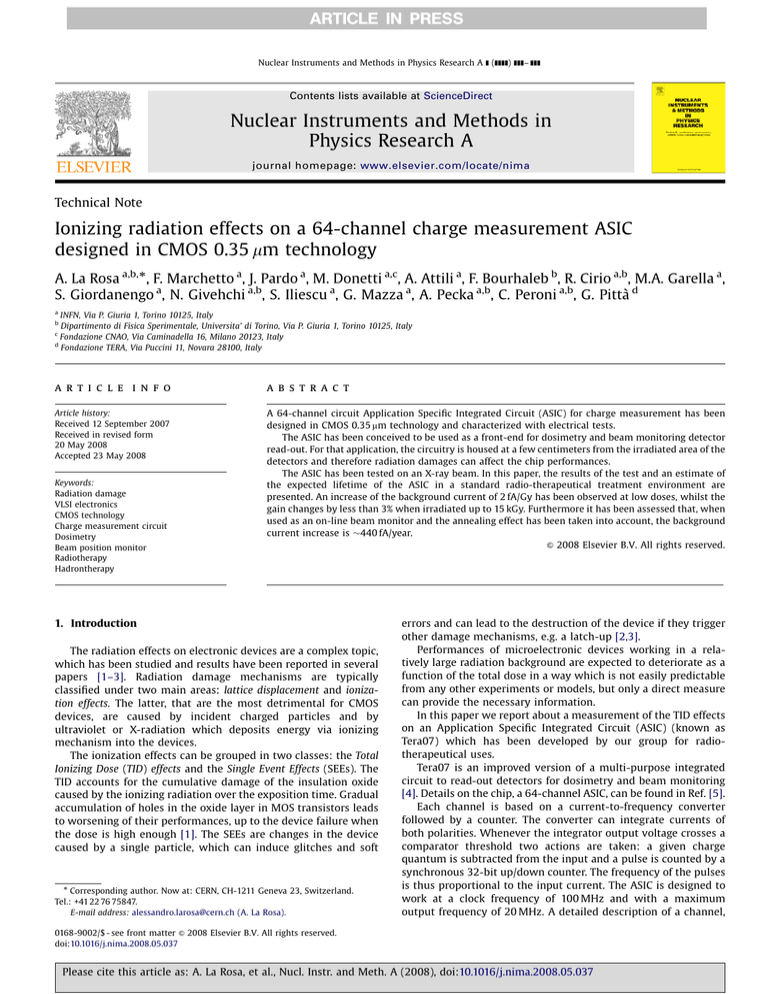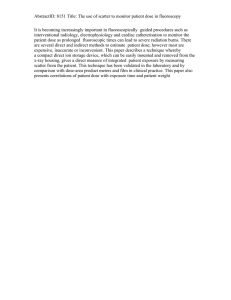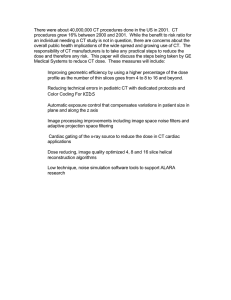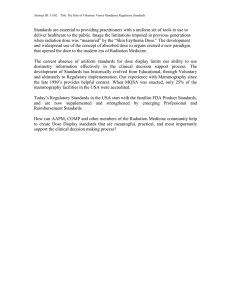
ARTICLE IN PRESS
Nuclear Instruments and Methods in Physics Research A ] (]]]]) ]]]– ]]]
Contents lists available at ScienceDirect
Nuclear Instruments and Methods in
Physics Research A
journal homepage: www.elsevier.com/locate/nima
Technical Note
Ionizing radiation effects on a 64-channel charge measurement ASIC
designed in CMOS 0.35 mm technology
A. La Rosa a,b,, F. Marchetto a, J. Pardo a, M. Donetti a,c, A. Attili a, F. Bourhaleb b, R. Cirio a,b, M.A. Garella a,
S. Giordanengo a, N. Givehchi a,b, S. Iliescu a, G. Mazza a, A. Pecka a,b, C. Peroni a,b, G. Pittà d
a
INFN, Via P. Giuria 1, Torino 10125, Italy
Dipartimento di Fisica Sperimentale, Universita’ di Torino, Via P. Giuria 1, Torino 10125, Italy
c
Fondazione CNAO, Via Caminadella 16, Milano 20123, Italy
d
Fondazione TERA, Via Puccini 11, Novara 28100, Italy
b
a r t i c l e in fo
abstract
Article history:
Received 12 September 2007
Received in revised form
20 May 2008
Accepted 23 May 2008
A 64-channel circuit Application Specific Integrated Circuit (ASIC) for charge measurement has been
designed in CMOS 0.35 mm technology and characterized with electrical tests.
The ASIC has been conceived to be used as a front-end for dosimetry and beam monitoring detector
read-out. For that application, the circuitry is housed at a few centimeters from the irradiated area of the
detectors and therefore radiation damages can affect the chip performances.
The ASIC has been tested on an X-ray beam. In this paper, the results of the test and an estimate of
the expected lifetime of the ASIC in a standard radio-therapeutical treatment environment are
presented. An increase of the background current of 2 fA/Gy has been observed at low doses, whilst the
gain changes by less than 3% when irradiated up to 15 kGy. Furthermore it has been assessed that, when
used as an on-line beam monitor and the annealing effect has been taken into account, the background
current increase is 440 fA/year.
& 2008 Elsevier B.V. All rights reserved.
Keywords:
Radiation damage
VLSI electronics
CMOS technology
Charge measurement circuit
Dosimetry
Beam position monitor
Radiotherapy
Hadrontherapy
1. Introduction
The radiation effects on electronic devices are a complex topic,
which has been studied and results have been reported in several
papers [1–3]. Radiation damage mechanisms are typically
classified under two main areas: lattice displacement and ionization effects. The latter, that are the most detrimental for CMOS
devices, are caused by incident charged particles and by
ultraviolet or X-radiation which deposits energy via ionizing
mechanism into the devices.
The ionization effects can be grouped in two classes: the Total
Ionizing Dose (TID) effects and the Single Event Effects (SEEs). The
TID accounts for the cumulative damage of the insulation oxide
caused by the ionizing radiation over the exposition time. Gradual
accumulation of holes in the oxide layer in MOS transistors leads
to worsening of their performances, up to the device failure when
the dose is high enough [1]. The SEEs are changes in the device
caused by a single particle, which can induce glitches and soft
Corresponding author. Now at: CERN, CH-1211 Geneva 23, Switzerland.
Tel.: +41 22 76 75847.
E-mail address: alessandro.larosa@cern.ch (A. La Rosa).
errors and can lead to the destruction of the device if they trigger
other damage mechanisms, e.g. a latch-up [2,3].
Performances of microelectronic devices working in a relatively large radiation background are expected to deteriorate as a
function of the total dose in a way which is not easily predictable
from any other experiments or models, but only a direct measure
can provide the necessary information.
In this paper we report about a measurement of the TID effects
on an Application Specific Integrated Circuit (ASIC) (known as
Tera07) which has been developed by our group for radiotherapeutical uses.
Tera07 is an improved version of a multi-purpose integrated
circuit to read-out detectors for dosimetry and beam monitoring
[4]. Details on the chip, a 64-channel ASIC, can be found in Ref. [5].
Each channel is based on a current-to-frequency converter
followed by a counter. The converter can integrate currents of
both polarities. Whenever the integrator output voltage crosses a
comparator threshold two actions are taken: a given charge
quantum is subtracted from the input and a pulse is counted by a
synchronous 32-bit up/down counter. The frequency of the pulses
is thus proportional to the input current. The ASIC is designed to
work at a clock frequency of 100 MHz and with a maximum
output frequency of 20 MHz. A detailed description of a channel,
0168-9002/$ - see front matter & 2008 Elsevier B.V. All rights reserved.
doi:10.1016/j.nima.2008.05.037
Please cite this article as: A. La Rosa, et al., Nucl. Instr. and Meth. A (2008), doi:10.1016/j.nima.2008.05.037
ARTICLE IN PRESS
2
A. La Rosa et al. / Nuclear Instruments and Methods in Physics Research A ] (]]]]) ]]]–]]]
the architecture of the chip, and the performances are reported in
Refs. [5,6].
Tera07 has been designed in a commercial CMOS 0.35 mm
technology, while previous versions were implemented in CMOS
0.8 mm. The decrease of the gate size and oxide thickness as well
as the improvement of the interface quality results in a strong
reduction of the radiation-induced trapped charges [7,8].
A radiation damage study has been done by testing a few chips
on an X-ray beam facility (SEIFERT RP149) at CERN. With this test
we address the damage due to X-ray effects essentially in the
oxide. As previously discussed, interactions with other types of
particles, such as hadrons, can cause atom displacement from the
lattice or SEE-inducing phenomena like latch-up and logic states
flipping [9]. These effects are not part of the test reported here. In
fact we focused the measurements to the circumstantial radiotherapeutical applications. In this practice, a low-energy X-ray
background is expected to irradiate the electronics and in
particular the ASIC chip hosted inside the case. The leaks through
the collimator and the large-angle scattering of the primary
radiation in the phantom are the sources of the X-ray background
to the ASICs. In Fig. 1 the layout of the front-end electronics
for a typical radio-therapeutical application is sketched
(see Refs. [10,11] for a detailed description): the ASICs are located
at a few centimeters from the active area of the detector. The
impact of the background at the ASIC level can be estimated with
usual dosimeters and it depends on the specific setup, namely the
linear accelerator and collimator type.
The paper is organized as follows: in Section 2 the experimental setup of the test is described, while in Section 3 the test
results are reported. In Section 4 the impact of the delivered dose
on the chip performances for typical on-line operations is
discussed. Conclusions are drawn in Section 5.
2. Experimental setup
The measurement of the X-ray beam damage on a chip can be
done with or without the case protection.
In the first approach it is possible to derive directly the
relationship between delivered dose and effect on the electronic
devices, while the latter is more focused on the effects of the
delivered dose on the final system. Indeed for the end-user the
relevant measurements are those performed with a conceivable
final setup. For this reason, to employ directly the test results in a
typical radio-therapeutical application of the chips the radiation
damage has been measured with the case.
One of the most fruitful applications of the Tera chips is their
use as front-end in 2D detectors for the measurement and
characterization of therapeutic photon or electron beams as in
the I’mRT MatriXX [12] device. For such applications, the amount
of leakage radiation to where the chips are positioned depends on
the setup, primarily the collimator. Furthermore, the leakage dose,
mainly due to soft photons with energy of the order of tens of keV,
can be directly measured.
The maximum voltage of the X-ray tube used in this test is
60 kV. The generated photons have been filtered by a 100 mm Al
window to cut off the low-energy spectrum (p10 keV) and finally
collimated to match the chip surface. The dose rate, up to
4 kGy/min, can be controlled via the tube current. The calibration
of the machine has been done using a PIN diode at 16 cm from the
X-ray exit collimator. For the test the chips have been placed at the
same distance of 16 cm from the collimator. The tube voltage has
been set to 50 kV and the dose rate in a range between 50 and
100 Gy/min.
The chip, occupying an area of (5.4 4.5) mm2, was enclosed in
a ceramic (Al2O3 min. 90%, density ¼ 3.7 g/cm3) package with a
cover 1.65 mm thick. The dose effectively transmitted through the
case has been evaluated with the Electron Gamma Shower (EGS)
Monte Carlo [13,14]. We found that only 78% of the photon
energy as measured at the case surface is then transmitted
through the case itself and reaches the chip. However, throughout
the paper we quote the delivered dose at the case rather than the
one to the chip.
The test was a sequence of the following operations: (a)
exposure of the chip to a given dose, followed by (b) the
measurements of the background current and the charge
quantum.
During the irradiation the ASICs have been powered and
clocked. For this purpose the chips have been mounted on a socket
housed in the irradiation test motherboard (so-called IRR-Board).
In Fig. 2 the experimental setup used during the irradiation is
sketched.
To acquire data a system based on a National Instrument PCI
DAQ card (PCI 6533) and the LabVIEW software has been used
[15,16]. The performances of the channels have been studied using
a Keithley 2400 voltage generator. It provides precision voltage in
the range between 1 mV and 211 V with an accuracy of 0.012%.
X-ray source
SEIFERT RP149
ASIC
Mylar window
X-ray
16 cm
ASIC
Motherboard
Anode
Power Supply
Clock
Cathode
Mylar window
Fig. 1. Exploded view of the pixel detector described in Ref. [10]: the location of
the ASICs is shown.
Fig. 2. Sketch of the irradiation setup used at the CERN facility to characterize
the ASIC.
Please cite this article as: A. La Rosa, et al., Nucl. Instr. and Meth. A (2008), doi:10.1016/j.nima.2008.05.037
ARTICLE IN PRESS
A. La Rosa et al. / Nuclear Instruments and Methods in Physics Research A ] (]]]]) ]]]–]]]
0
0
-20
-2
-40
Background Current (pA)
The voltage, via a 10 MO resistor, supplies the current injected into
the channel. During these tests the chips have been mounted in a
socket that is housed on the test board (so-called TestBoardTERA07).
The main function of the board is to adapt the ASIC voltage
levels and line topology to the PCI DAQ card. A detailed
description of TestBoard-TERA07 is presented in Ref. [5].
To assess the degradation of the chip performances, measurements of the background current and charge resolution were
repeated as a function of the delivered dose up to 15 kGy. The full
procedure was completed in a day.
3
-4
-60
-6
-80
0
500
1000
-100
-120
-140
3. Test and results
50 fC
100 fC
200 fC
-160
The ASIC has been previously characterized (see [5]) by
measuring:
background currents;
effective gain for different charge quanta;
linearity of the current-to-frequency converter.
The background current is less than 500 fA with a mean value
of 230 fA, while the spread (r.m.s.) of the charge quantum is 4.3%
for a gain of 50 fC and less than 1% for 350 fC. The ASIC has a very
good linearity for both positive and negative currents over a
current input dynamic range of four orders of magnitude, from
500 pA to 3 mA.
The radiation damage studies discussed in this paper address
the total dose effects on the ASIC performances and the recovery
effect.
To study the total dose effects the chips have irradiated in
several dose steps up to 15 kGy. After each irradiation, the
following parameters have been measured for charge quanta of
50, 100, and 200 fC, hereafter referred as reference settings:
the counts due to background current, corresponding to open
input;
the gain.
For a typical channel, the background current is shown in Fig. 3
as a function of the integrated delivered dose. Fig. 3 shows that,
independently of the charge quantum, the pedestals increase with
the integrated dose. As an example, for a given channel with the
charge resolution set to 50 fC, a background of 250 fA has been
measured before irradiation, which increased to 150 pA at 15 kGy.
The background current is almost independent of the charge
quantum: this indicates that the capacitor values are not affected
by the radiation.
After each irradiation the charge quantum has been measured
for both polarities. Therefore, the charge quantum distribution has
been measured for the reference quanta settings and for both
positive and negative polarities.
In Fig. 4, for a typical channel we show the charge quantum
distribution versus the integrated delivered dose for three
different Q values: 50 fC in (a), 100 fC in (b), and 200 fC in (c).
We remark that the differences between design and experimental
gain values are explained by the spread of the capacitance values
for this technology (710%). The measured charge quantum
increases with the dose for positive currents (dots) and decreases
for negative ones (square). This is consistent with the fact that the
measured background current is negative and its absolute value
increases with the irradiation. In fact, for a positive input current
the effect of the negative leakage is to decrease the net current
and therefore appears as a reduction of the gain (and thus as an
-180
0
2000 4000 6000 8000 10000 12000 14000 16000 18000
Integrated Dose (Gy)
Fig. 3. Background current as a function of the integrated X-ray dose for different
charge quanta; the inset shows the trend for doses up to 0.8 kGy. Statistical
uncertainties are within the dimension of the symbols.
increase of the charge quantum). For negative currents the effect
is reversed, thus leading to a decrease of the charge quantum of
the same quantity. Over a range of 15 kGy the deviation of the gain
for both positive and negative input currents with respect to the
average value is less than 10% for 50 fC and 3% for 200 fC. It should
be noted that the above deviations can be easily corrected for with
the standard periodical gain calibration. Indeed the data show
that the radiation damage effects are limited to the background
current, which increases almost linearly and becomes three orders
of magnitude bigger for an integrated dose of 15 kGy.
However, it is known that in silicon devices time and
temperature can trigger a self-recovery process, which is known
as annealing. In short, the net effects of the irradiation result in an
accumulation of holes which remain trapped in the oxide near the
SiO2–Si interface that with time tend to decrease. Two phenomena are the base for the explanation: a tunnel-effect-based
annealing originates the recombination of the electrons into the
trapped holes [17,18] and a thermal annealing for which electrons
escape the valence band and recombine with the holes.
The self-recovery process has been studied as a function of
time after irradiation. For this study the value of the background
current and the charge quantum have been measured at regular
time intervals. The self-recovery effect is shown in Fig. 5: the
background current for a typical channel is plotted as a function of
the number of days after the irradiation. A measurement of the
background after 1.5 years shows that the recovery is not
complete and a background current of 12 pA remains after the
annealing process is saturated. From the distribution of the
experimental points we infer the hypothesis that two processes
play a significant role in the overall neutralization of the holes
trapped close to the SiO2–Si interface. The recovery can be
described by the sum of two exponential trends, which account
for a short- and a long-term annealing, and an asymptotic
saturation, A3, fixed by the measurement to 12 pA:
IðtÞ ¼ A1 expðt=t1 Þ þ A2 expðt=t2 Þ þ A3
(1)
By fitting the experimental points to Eq. (1), it was found that
t18 days and t241 days. This indicates that two annealing
processes compete with each other: a faster one having a time
constant of 8 days and a slower mechanism with a much larger
time constant. These two processes may correspond to the tunnel
effect base and the thermal annealing. In Fig. 5 the fit result, I(t), is
Please cite this article as: A. La Rosa, et al., Nucl. Instr. and Meth. A (2008), doi:10.1016/j.nima.2008.05.037
ARTICLE IN PRESS
4
A. La Rosa et al. / Nuclear Instruments and Methods in Physics Research A ] (]]]]) ]]]–]]]
160
140
8
6
Negative Current
Positive Current
4
2
0
-2
-4
-6
-8
background current (pA)
Charge Quantum Varation (%)
10
120
100
80
60
40
20
-10
0
2000
4000
6000 8000 10000 12000 14000 16000
Integrated Dose (Gy)
0
0
10
20
30
40
time (days)
50
60
70
Charge Quantum Varation (%)
5
4
3
Negative Current
Positive Current
2
1
0
-1
-2
-3
-4
0
2000
4000
6000 8000 10000 12000 14000 16000
Integrated Dose (Gy)
3
Charge Quantum Varation (%)
Fig. 5. Absolute value of the background current for a charge quantum of 50 fC as a
function of time after an integrated X-ray irradiation of 15 kGy: the continuous line
shows the function described in Eq. (1) with t1 ¼ 8 days and t2 ¼ 41 days. The
dash–dotted line shows the annealing saturation as measured after 1.5 year.
Statistical uncertainties are within the dimension of the symbols.
2.5
2
complex, but when limited to a specific case some conclusions can
be drawn. The following analysis is focused on an application
where the chips are used to monitor on-line therapeutic
treatments with photon or electron beams: in this case each
single field delivery to a patient is monitored, resulting in a very
intensive use of the detector. This is a worst case with respect to
the use of the ASICs for Quality Assurance (QA) of the beam and
for the treatment planning: in this respect the detector is used
typically once per day and the amount of irradiation is at least an
order of magnitude smaller.
To evaluate the expected dose delivered to a chip during the
treatment the following assumptions have been made:
Negative Current
Positive Current
A typical standard treatment fraction is designed to deliver
1.5
2 Gy to the patient target.
1
A conservative estimation of the fraction of the dose to the
0.5
0
-0.5
-1
-1.5
0
2000
4000
6000 8000 10000 12000 14000 16000
Integrated Dose (Gy)
Fig. 4. (a) Charge quantum variation as a function of the integrated X-ray dose for
a nominal charge quantum of 50 fC. Statistical uncertainties are within the
dimension of the symbols. (b) Charge quantum variation as a function of the
integrated X-ray dose for a nominal charge quantum of 100 fC. Statistical
uncertainties are within the dimension of the symbols. (c) Charge quantum
variation as a function of the integrated X-ray dose for a nominal charge quantum
of 200 fC. Statistical uncertainties are within the dimension of the symbols.
reported (full line) together with the exponential curves (dashed
lines), showing both fast and slow component. The annealing
saturation leaves a background current, which is reported as a
dash–dotted line.
A second chip irradiated with a total dose of 6.9 kGy showed
similar trends.
4. Discussion
It is worthwhile to discuss in more detail the interplay
between damage and self-recovery: in general the topic is rather
ASIC is 1%. This figure is substantiated by several measurements with different setups.
The average number of patients per day is 100 corresponding
to a total delivered dose to the ASICs of 2 Gy/day (100 patients
2 Gy/patient 0.01).
The treatment session lasts for 12 h during the day.
The total number of treatment days per year is 260, divided
into 52 weeks of 5 working days.
Taking into account the above assumptions, it can be estimated
that the detector-sensitive area will receive an integrated dose of
52 kGy/year, while the ASIC will receive a dose of 520 Gy/year.
To study the impact of the radiation damage taking into
account the self-recovery effect, the background current Ibckg can
be modeled as a result of the product of two functions. The first
function is a parameterization of Ibckg as a function of the dose D:
(Ibckg0+aD+bD2), where Ibckg0 is the background current before the
dose D has been delivered, a ¼ 2 fA/Gy and b ¼ 2.5 103 fA/Gy2
are the linear and quadratic term, respectively. Ibckg0, a and b have
been derived from Fig. 3 by fitting the low-dose inset (Do1.6 kGy)
of the plot to a quadratic curve. The second function is Eq. (1): we
assume that, after the annealing occurs, the background current
saturates to a value which scales linearly with the total dose. The
model included the expected time sequence: 52 weeks, each with
5 working days dedicated to treatments during 12 h.
After 1 year of operations the expected background current
increases by 440 fA from 230 to 670 fA. Based on the above
Please cite this article as: A. La Rosa, et al., Nucl. Instr. and Meth. A (2008), doi:10.1016/j.nima.2008.05.037
ARTICLE IN PRESS
A. La Rosa et al. / Nuclear Instruments and Methods in Physics Research A ] (]]]]) ]]]–]]]
figure it is possible to conclude that the effect of the radiation
damage on the background current is marginal and, on the other
hand, the effect on the gain can be easily taken into account by the
routine periodic calibration.
5. Conclusions
An ASIC in CMOS 0.35 mm technology has been developed to be
used as front-end electronics for the read-out of multi-channel
detectors. The 64-channel chip is a charge measurement circuit:
the quantization error (charge quantum) can be selected in the
range between 25 and 1155 fC for a maximum input current of
3 mA. The background current (open input) is 230 fA.
The ASIC can fit many applications; it has already been used for
the read-out of several types of detectors [10–12].
In a typical application the front-end electronics is housed at a
few centimeters from the irradiation area of the detectors: for this
reason we have studied the radiation damage to the ASIC due to
soft photon irradiation.
From the performed test it has been found that the background
current increases almost linearly with a rate of 2 fA/Gy for low
absorbed dose (up to 100 Gy) and quadratically for larger doses.
The charge quantum changes as a function of the delivered dose
up to 15 kGy within 10% for 50 fC down to 3% charge for 200 fC.
The self-recovering process and its effect on the background
current have been studied; it can be represented by the sum of two
exponential functions: a short term with time constant of 8 days is
followed by a slower process with a time constant of 41 days.
However, the annealing process shows a saturation effect and a
background current remains even after many time constants. From
these measurements it is possible to conclude that by using the
detector as on-line beam monitor and inferring typical operation
conditions the background current would increase by 440 fA/year.
However, this figure is still at least three orders of magnitude
smaller than the expected current range for typical measurements.
5
Acknowledgements
We would like to thank G. Anelli and F. Faccio for their kind and
efficient assistance in the use of the irradiation CERN facility. This
work has been partially supported by the European Integrated
Project MAESTRO, which is granted by the European Commission
(Methods and Advanced Equipment for Simulation and Treatment
in Radio-Oncology, No. LSHC-CT-2004-503564, 1 May 2004–30
April 2009).
References
[1] T.P. Ma, Paul V. Dressendorfer, Ionizing Radiation Effects in MOS Devices and
Circuits, Wiley-IEEE, ISBN 047184893X, 1989.
[2] P.S. Winokur, Ionizing Radiation Effects in MOS Devices and Circuit, Wiley,
New York, ISBN 047184893X, 1998.
[3] Di Cor L. Claeys, Eddy Simoen, Technology & Industrial Arts (2002).
[4] A. La Rosa, et al., Nucl. Instr. and Meth. A (2008).
[5] A. La Rosa, et al., Nucl. Instr. and Meth. A 583 (2007) 461.
[6] G. Mazza, et al., IEEE Trans. Nucl. Sci. NS-52 (4) (2005) 847.
[7] M. Campell, et al., Nucl. Instr. and Meth. A 473 (2001) 140.
[8] G. Anelli, Design and characterization of radiation tolerant integrated circuits
in deep submicron CMOS technologies for the LHC experiments, Ph.D. Thesis,
Institut National Polytechnique de Grenoble, France, December 2000, also
available at /http://www.cern.ch/RD49S.
[9] Di Len. Adams, Holmes-Siedle, Andrew Holmes-Siedle, Handbook of Radiation
Effects, Oxford University Press, ISBN 019850733X, 2002.
[10] A. La Rosa, et al., Nucl. Instr. and Meth. A 565 (2006) 833.
[11] N. Givehchi, et al., Nucl. Instr. and Meth. A 572 (2007) 1094.
[12] Information about the product can be found at the web page /http://
www.scanditronix-wellhofer.com/I_mRT_MatriXX.957.0.htmlS.
[13] W.R. Nelson, H. Hirayama, D.W.O. Rogers, The EGS4 Code System, Report
SLAC-265, Stanford Linear Accelerator Center, Stanford, CA, 1985.
[14] D.W.O. Rogers, Nucl. Instr. and Meth. 227 (1984) 535;
D.W.O. Rogers, Nucl. Instr. and Meth. A 227 (1984) 535.
[15] Information about the product can be found at the web page /http://sine.
ni.com/nips/cds/view/p/lang/en/nid/201912S.
[16] Information about the product can be found at the web page /http://www.
ni.com/labviewS.
[17] H.E. Boesch Jr., F.B. MCLean, IEEE Trans. Nucl. Sci. NS-32 (6) (1985) 3940.
[18] P.J. McWhorter, et al., IEEE Trans. Nucl. Sci. 37 (6) (1990) 1682.
Please cite this article as: A. La Rosa, et al., Nucl. Instr. and Meth. A (2008), doi:10.1016/j.nima.2008.05.037





